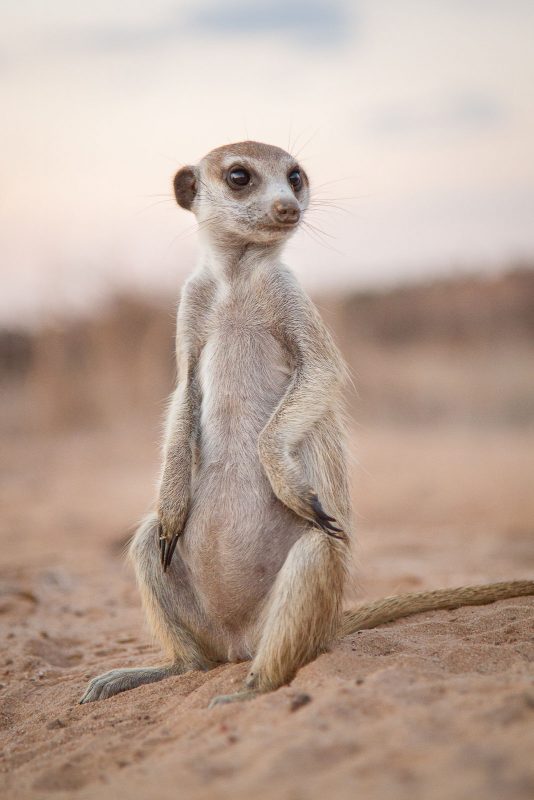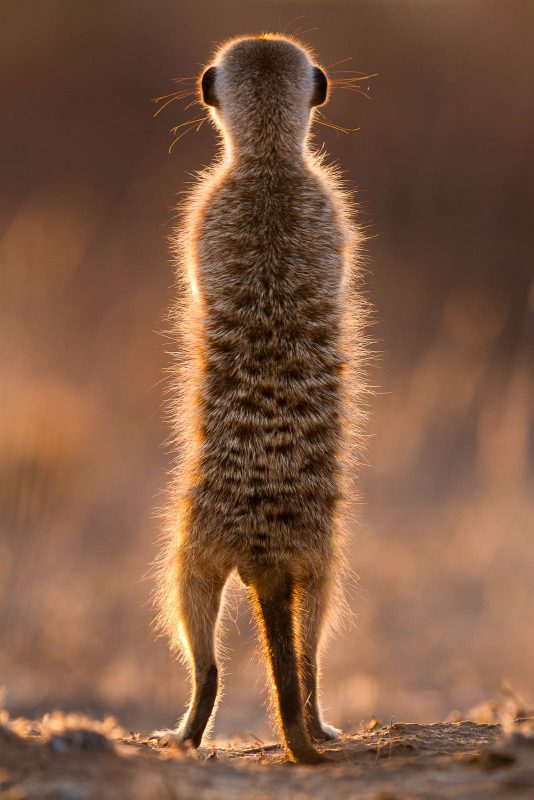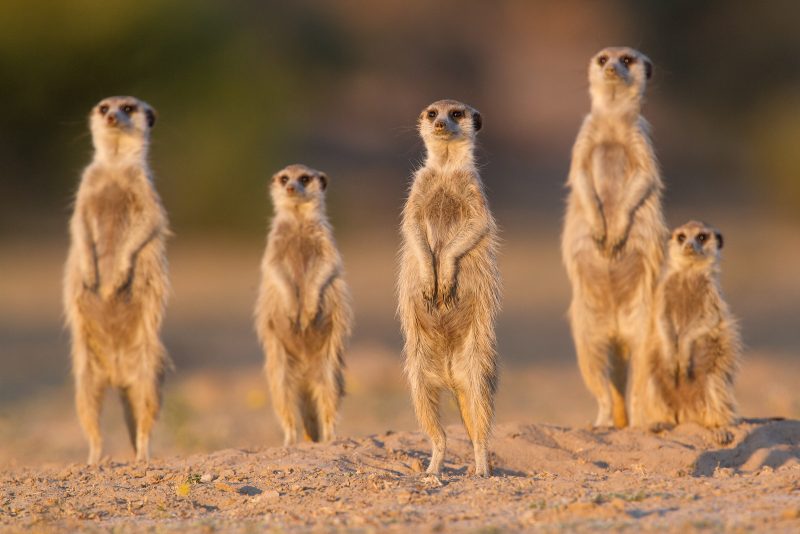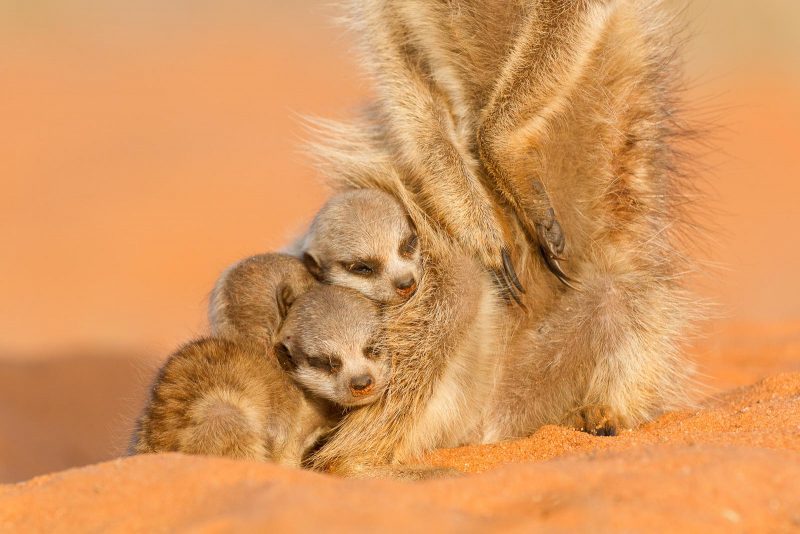How to Photograph Meerkats

Meerkats are great animals for photography for several reasons. They are highly active throughout most of the day all year round, they are highly social with many interesting behaviours and, most crucially for photography, there are many habituated groups that will act as if you weren’t there at all no matter how close you get.
It is possible to walk amongst meerkats as if you were a ghost, without affecting their natural behaviour. If you sit down in a flat area they will even climb up your back and use your head as a lookout post.


My photos of meerkats were taken when I worked as a researcher at the Kalahari Meerkat Project. During this time I spent a whole year surrounded by habituated meerkats, studying their behaviour.
Where and when to photograph meerkats
Meerkats are found throughout the Kalahari areas of South Africa, Botswana, and Namibia. They are specialists at digging in the soft sandy soils.
Meerkats are widespread and relatively common throughout their range, but the main places where you can visit and walk amongst habituated groups are:
- Kalahari Meerkat Project – they do accept visits from guests and there is bookable accommodation.
- Tswalu Kalahari Reserve – a private game reserve with luxury accommodation.
- Makgadikgadi Pan in Botswana.
- Kgalagadi Transfrontier Park – A “national” park which spans the border between South Africa and Botswana.
Tours and guides can be booked at each of these places specifically to see meerkats.
The best time to photograph meerkats would be in the austral summer (November to April). This is because, in the winter, it can get very cold and the meerkats won’t come up from their burrows until the ground has started to warm up; by that time you will have missed the best light.
The austral summer is when the rains fall and, depending on the climate that year, it could be greener with a higher abundance of prey items. This is also the time when it is most likely you will be able to see pups.
Meerkat behaviour
Whereas some animals can be tricky to even catch a fleeting glimpse of, the beauty of photographing meerkats is that when with a habituated group you can witness a large variety of intimate behaviours at very close range.
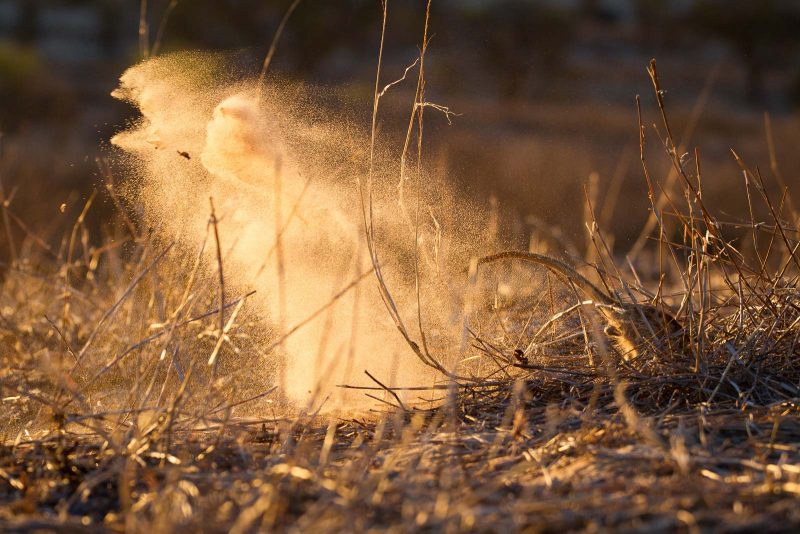
Meerkats are highly social animals that live in groups, usually of 8-10 individuals. Much of their interesting behaviour comes from the social dynamics of the group, which will be led by an alpha female who is usually the mother of most of the other members of the group.
The meerkats’ daily routine is to wake up from the sleeping burrow, roughly at sunrise, then head off (at a slowish human walking pace) away from the burrow for the day’s foraging. They usually head away from the burrow in the morning and return in the evening, but change which sleeping burrows they use every 3-5 days.
Here are some of the interesting behaviours to look out for during your meerkat photography experience.
1. Guarding
Quite often, while the rest of the group is foraging, one meerkat will act as sentinel by climbing to a high vantage point and watching for predators. This is a good chance to get wider shots of a meerkat in the landscape, as they may not be surrounded by so much vegetation.
Read more: How to Photograph Animals in Their Habitat
2. Feeding
Meerkats feed on a large variety of prey items, usually dug from beneath the surface of the sand. They have different methods of dealing with distasteful, and potentially dangerous, prey such as scorpions.
They generally dig for food with their heads in the sand, so you will usually only have a moment or two when they come up before they have munched their prey.
3. Sunbathing
The Kalahari can get cold at night and meerkats will sunbathe in the first light of cold mornings. Sometimes the whole group will line up and sunbathe together, giving great opportunities for different compositions.
4. Playing
Younger members of the meerkat group are very playful and spend a lot of time wrestling with each other. Sometimes slightly older individuals get sucked in too!
This can be hectic to shoot, so fast frame rates and good focusing skills needed.
5. Grooming
Grooming each other is very important in meerkat society; it appears to strengthen the social bonds between individuals. This would normally take place at the burrow before leaving in the morning, or after returning in the evening.
This is also a great chance for a some slower-paced behaviour and more intimate shots.
6. Care of pups
During the first weeks of life, meerkat babies will be left at the burrow with “babysitters” that look after the young whilst the alpha female is out foraging.
When they are able to venture out, the adults will bring the pups food items which will be disabled in various states depending on the age and experience of the pups.
7. Mobbing
Meerkats are well known for this behaviour. When they encounter a ground-based predator, such as a snake, the whole group comes together as one to confront and attack it.
It is a very rare behaviour to see, so you’d be very lucky to photograph this!
Read more: Backlighting in Wildlife Photography – Creative Use of Light
Equipment for meerkat photography
1. Medium telephoto lens
As you can get so close to meerkats in habituated groups, you can leave the big telephotos at home. I’d recommend a 70-200mm or even a 300mm f/2.8.
As you’ll probably be as low as possible and need to move quickly to keep up with the behaviour, I’d also leave the tripods and monopods at home.
2. Wide-angle lens
When you can get this close, why not try a relatively close focus wide-angle lens to show some environment?
Try this with a meerkat on sentinel duty or by getting really low and shooting upwards at standing meerkats for a unique perspective.
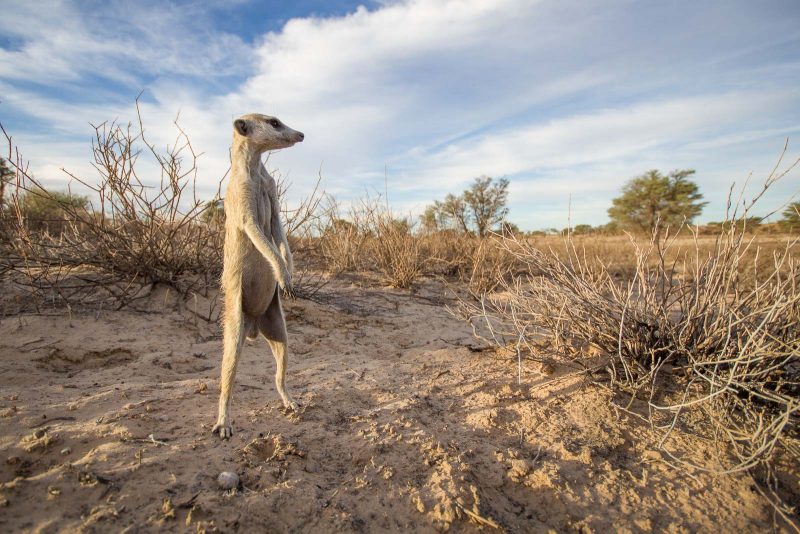
Top tips for meerkat photography
1. Get down low
90% of my photos were taken laying flat on my stomach. This will get you right down at eye-level and will help with nice foreground and background depth.
2. Keep ahead of the group
I’d recommend getting a sense of the direction a foraging group is going and then running ahead and waiting for them to catch up. Otherwise, you’ll be constantly on the run and generally get images of the back-end of meerkats.
3. Work at dawn and dusk
The light gets very harsh after an hour or two of the sun being up, but the lack of clouds makes for rather awesome lighting just after sunrise and before sunset. This is also the time when the meerkats will be waking up, sunbathing, or returning to the burrow
4. Follow the dominant individual or pups
Aside from feeding and guarding behaviours, the most interesting behaviours normally involve the dominant female (or male), or the pups. Staying with either of these can yield good results.
5. Try backlighting
As the light can be fantastic at dawn and dusk, this can really lend itself to backlighting. This helps to pick out the sleek shape of a meerkat’s body, and also the details like whiskers.
6. Be quick!
Meerkats are fast-moving and any behavioural action can happen in split seconds. Knowing your camera well can give you quicker response times, as can sitting and watching without your camera for a while to give you clues to behaviour before it happens.
7. Work with multiple meerkats
As meerkats are so social, it is really worth trying to compose images with multiple animals in. This can be especially rewarding when they are sunbathing at the burrow in the mornings, as they will often stand in a line.
In conclusion
The level of habituation of some of the more readily-visited groups really gives a lot of freedom to photograph intimate behaviour.
This is a completely different experience if you are used to waiting for hours in a hide, or being restricted to a safari vehicle.
Take the opportunity of working with such a bold animal to be more creative with your shots and try something new. Good luck!


